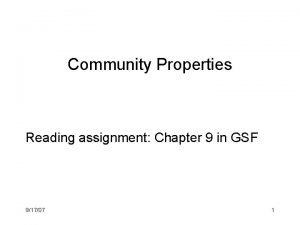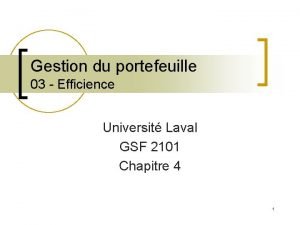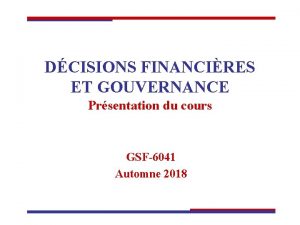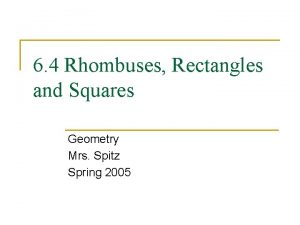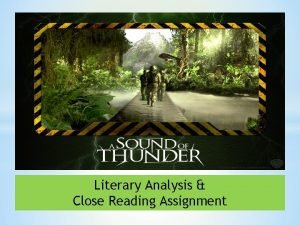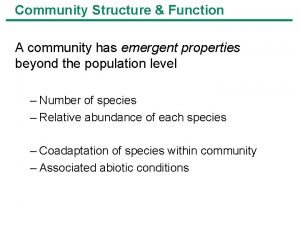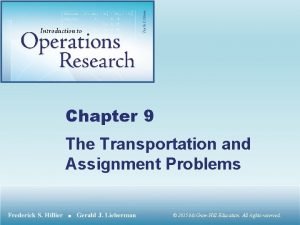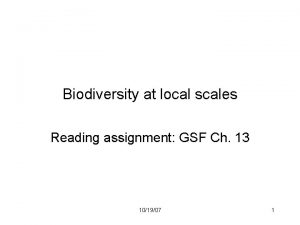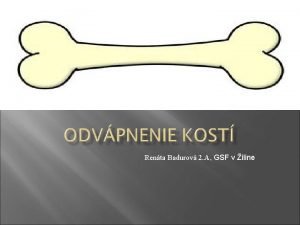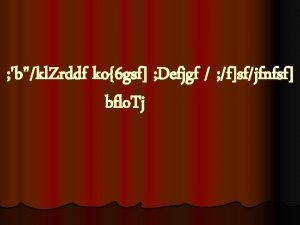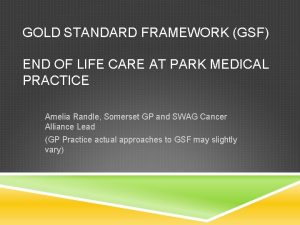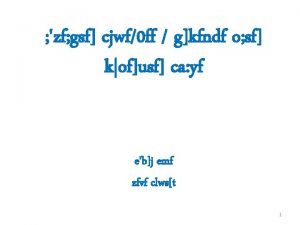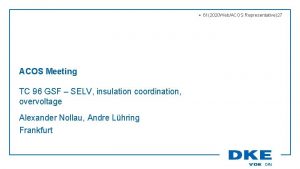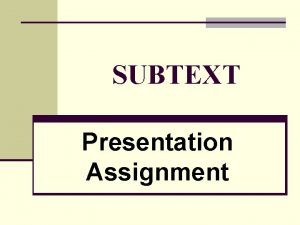Community Properties Reading assignment Chapter 9 in GSF




















- Slides: 20

Community Properties Reading assignment: Chapter 9 in GSF 9/17/07 1

Describing Plant Communities (functional groups) • What is a community? Box 9 A • How are community boundaries defined? 9/17/07 2

Different views of plant communities · Clements’ “super-organism” concept · all species are mutually interdependent · these relationships benefited the whole community – focused on biotic factors, but acknowledged abiotic factors controlling community development – highly predictable trajectory and end points • emergent properties 9/17/07 3

Different views of plant communities • Gleason’s individualistic concept – emphasized abiotic and biotic factors, plus chance historical events. – individual species have boundaries (tolerance ranges) at different places along environmental gradients – within a species’ range, chance events determined whether the species is found in a given place – in his view, communities were arbitrary human constructs 9/17/07 4

Fig. 9. 1 Whittaker’s and Curtis’ research strongly supported Gleasonian theories, which finally became accepted 9/17/07 5

Fig. 9. 2 9/17/07 6

Measurable attributes of plant communities • • • Physiognomy Species composition Species distributions • Nutrient cycling Species diversity • Change over time Stand structure Canopy structure • Productivity 9/17/07 7

Attributes… • Physiognomy – life form (size, life span, woodiness, morphology, leaf traits, location of perennating buds, phenology), – vertical structure (height, canopy cover, leaf area index) – LAI=total leaf area/ground area • Species composition – Species richness r = # species in a community – Species evenness is a measure of the distribution of individuals among species – Species diversity is species richness weighted by species evenness – Species density is # species per unit area 9/17/07 8

Quantifying vegetation • Cover = percent of ground area covered by a species – Basal area is commonly measured in forests – Canopy cover is commonly measured in grasslands • Density = number of individuals per unit area • Frequency = percent of quadrats in which a species appears • These values can be relativized so that all species add up to 100% • Another approach is to combine several relative measures into a single importance value (IV): – IV = relative cover + relative density + relative frequency for each species – often done in forests 9/17/07 9

9/17/07 10

Species-area curves demonstrate species richness • Species richness increases as the area sampled increases, as shown by a species-area curve • This is a common test to evaluate sampling adequacy 9/17/07 11

Patterns of species richness • Species richness is not constant through space. SR (for plants and animals) is negatively related to: – latitude – altitude • positively related to: – area – environmental variability • and have a complex relationship with: – – time since disturbance nutrients predation rate productivity • Islands tend to have low SR 9/17/07 12

Diversity decreases with increasing latitude 9/17/07 13

Species evenness • provides a measure of the relative dominance of individual species • is most useful when combined into a diversity index 9/17/07 Which is more even? Which is more diverse? 14

Three scales of biodiversity (Whittaker 1975) • Alpha diversity: diversity within a single community • Beta diversity, change in community composition across an environmental gradient • Gamma diversity, total diversity across several communities, “landscape-level” diversity 9/17/07 15

Indices of alpha diversity • Shannon-Wiener index: - – where H’ is “information” of community – pi is the proportion of individuals (or cover) of the ith species – Assumes individuals were sampled from a very large population, and that all species are represented in sample – Requires actually knowing the true number of species – This can introduce bias – Useful if the goal is to assess the importance of rare species 9/17/07 16

Indices of alpha diversity (con’t) • Simpson’s index: – where L is index value, s is total # species in sample, pi is proportion of all individuals (or cover) of species i. – Measures the chance that 2 individuals chosen at random from the same community belong to the same species – Can be estimated without sampling bias – Sensitive to changes in proportions of common species – Not so good for assessing rare species 9/17/07 17

9/17/07 18

Forest stand structure • Tree species, sizes and sometimes ages are measured in known areas • Can be used to estimate timber volumes • Next week we will learn one way to assess stand structure 9/17/07 19 http: //silvae. cfr. washington. edu/ecosystem-management/images/structure 1. jpg

Forest Canopy Structure • Can provide a view of demographics or potential successional trends • Canopy classes are recorded, for example: D - Dominant is 25% or more of the tree crown is above main forest canopy. C - Codominant is when the tree crown is within main forest canopy. I - Intermediate is 25% or more of lower crown below main forest canopy. S - Suppressed is whole crown of tree below main forest canopy. G – Gap is when the tree has no neighbors nearby its canopy. 9/17/07 20
 Gsf reading
Gsf reading Gsf-2101
Gsf-2101 Gsf-6041
Gsf-6041 Gsf caen
Gsf caen While reading activities
While reading activities Properties of rectangles assignment
Properties of rectangles assignment Close reading assignment
Close reading assignment What is intensive in chemistry
What is intensive in chemistry Chemical property of water
Chemical property of water Functions of community
Functions of community Evaluate together in community mobilization
Evaluate together in community mobilization St. louis
St. louis What are the aims of teaching reading?
What are the aims of teaching reading? Types of readings
Types of readings Edb net section
Edb net section Reading is an active process
Reading is an active process Real definition of extensive reading
Real definition of extensive reading Intensive reading and extensive reading
Intensive reading and extensive reading What is reading
What is reading Chapter 9 transportation and assignment models solutions
Chapter 9 transportation and assignment models solutions 2009 delmar cengage learning
2009 delmar cengage learning
